How To Draw Venom With No Legs Just Is Slime
The Tale of Toxicofera, part v (snake venom glands)
Afterward last week's courageous practice in contend-sitting regarding the venomousness of varanid lizards, this week we're jumping back onboard the anatomy railroad train to have the gland track to…. more controversy and ambiguity. Snakes are the archetypal venomous reptiles, and then you lot would exist excused for thinking that it must be easy to concord upon which species are venomous and which aren't, and what exactly qualifies as a serpent "venom gland". Again, thanks to the treasure trove of transitional forms that is the Toxicofera, things are not quite and then simple.
Dental gland redux
If you've been following the Tale then far, you know that the "toxin-secreting" oral glands that the clade Toxicofera derives its name from exist in myriad forms within the clade. What seems fairly clear is that the almost recent mutual ancestor (MRCA) of all toxicoferan lizards (including snakes) possessed "dental glands", which are one of the synapomorphies (shared derived traits) of the clade. Since the fourth dimension of that antecedent, these dental glands accept diversified differently in the various toxicoferan lineages. In part iii, we had a look at the dental glands of iguanian and anguimorph lizards. We saw that the dental glands of iguanian lizards seem relatively unchanged since the time of the MRCA, but that those of anguimorph lizards are more than various and have evolved into fully fledged "venom glands" in at least one (Helodermatidae) and possibly two (Varanidae/Lanthanotidae) lineages. In snakes, the evolution of oral glands entered warp speed in parallel with the diversification of their strategies for subduing prey without the employ of limbs (imagine communicable, subduing and swallowing an animal with your hands tied behind your back and your legs tied together).
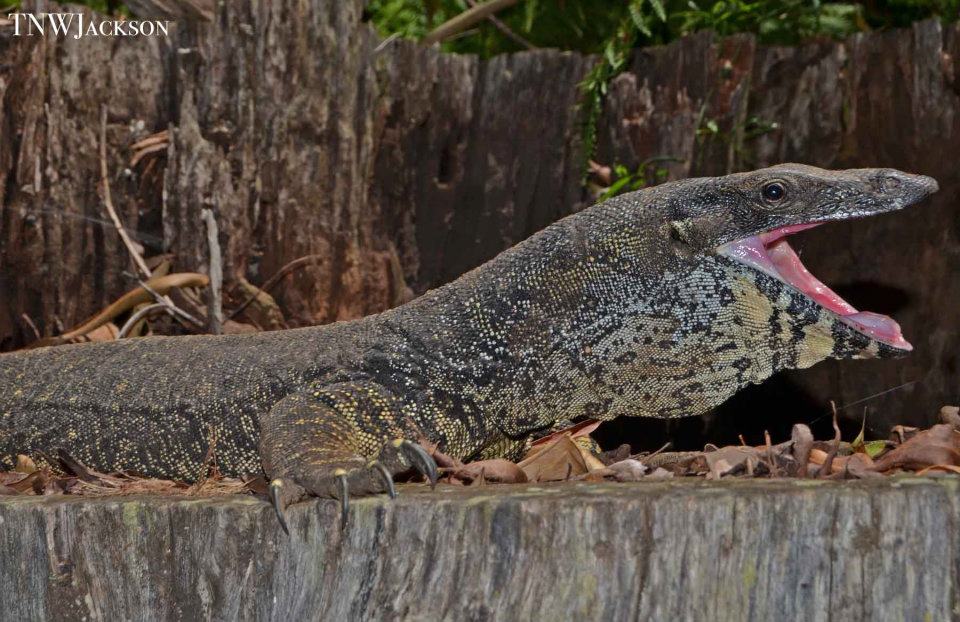
Bear witness united states of america your dental glands! A lace monitor (Varanus varius) says "aaaaaaaaah". This gaping beaviour is a threat display, indicating that the cadger will not hesitate to bite if information technology feels it cannot escape. Equally discussed in the previous episode of the Tale of Toxicofera, whether nor not monitor lizards should be considered "venomous", information technology's their teeth that do near of the damage, and this is particularly true for lace monitors, which have large, serrated teeth designed for shearing flesh. Photo: Timothy Jackson.
Evolutionary series
The diversity of oral gland beefcake amongst snakes makes deconvoluting the evolutionary history of these structures challenging but rewarding for evolutionary biologists. I've said this previously, but information technology is the preservation of "evolutionary series" of dental glands inside extant toxicoferan reptiles that makes the clade such a valuable resources for researchers interested in the emergence of functional traits. Such evolutionary serial should not be taken to culminate in the evolution of specialised venom systems whatsoever more than the evolutionary history of life on earth should exist seen to culminate in humanity. However, when we frame the development of anatomical structures in relation to the existence of a particularly conspicuous functional trait – such equally venom – we take the opportunity to learn a nifty bargain nearly how such traits emerge. Thus, within toxicoferan reptiles nosotros may consider the existence of a spectrum of "venom systems", from marginal to paradigmatic cases. Paradigmatic venom systems are those which are unequivocally specialised for the production and delivery of venom, such as the "high-pressure level" venom commitment systems of snakes (which we volition discuss in below) or scorpions and many other venomous invertebrates. Marginal venom systems, on the other mitt, may be either "incipient" or "vestigial". An incipient venom system does not possess the part of venom production and delivery and never has just has characteristics that have been developed for that function in other lineages. The dental glands of iguanian lizards are incipient venom systems in this sense, because dental glands are the evolutionary precursors to every reptilian venom organization nosotros know virtually. A vestigial venom arrangement, on the other hand, is the remnants of a formerly functional venom system that has ceased to play a role in the feeding environmental of the organism and has thus begun to decay, similar the discarded old rust saucepan falling into disrepair on your neighbour's front backyard. As nosotros shall see, vestigial venom systems are not uncommon amongst snakes.
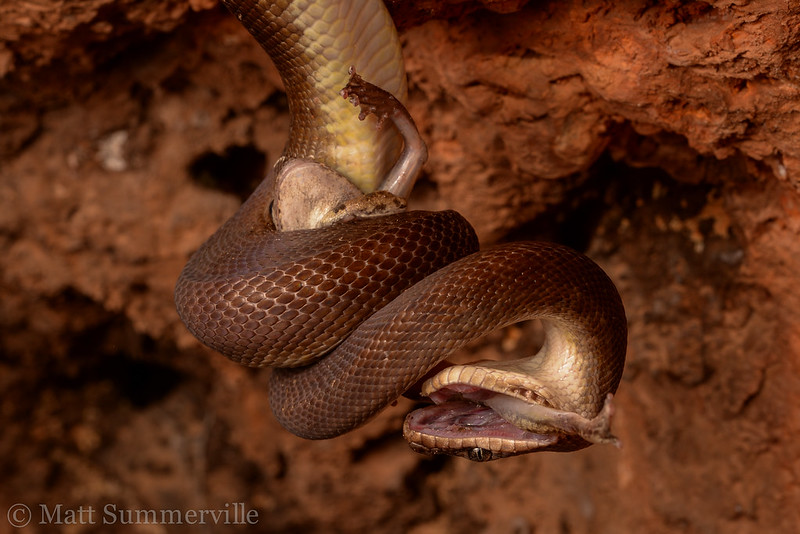 The rictal glands (meet text for discussion) of pythons may exist the vestiges of larger toxin-secreting oral glands possessed by ancestral snakes. Pythons, such equally this Children'south python (Antaresia childreni) subduing a frog, are specialised constrictors, and therefore have little demand of venom to subdue their casualty. Photo: Matt Summerville.
The rictal glands (meet text for discussion) of pythons may exist the vestiges of larger toxin-secreting oral glands possessed by ancestral snakes. Pythons, such equally this Children'south python (Antaresia childreni) subduing a frog, are specialised constrictors, and therefore have little demand of venom to subdue their casualty. Photo: Matt Summerville.
Slime factories
In contrast to anguimorph lizards (see part 3), among snakes it'southward nigh exclusively the dental gland of the peak jaw (the maxillary dental gland) that has become specialised for toxin production. Typically, snake dental or labial (associated with the lips) glands of the height jaw have segregated mucous and serous (protein) secreting regions, with the mucous-secreting regions proximal (towards the nose) to the protein-secreting regions (which are under and behind the middle). In non-venomous lineages that have specialised for constriction (e.thou. pythons), the poly peptide-secreting portion of the glands has been reduced almost to zero, and the large "labial glands" secrete mucous most exclusively. This capacity for producing a surfeit of slime is important for these snakes that are able to subdue uncommonly large prey and are unable (like nearly all snakes) to pause the prey autonomously. Swallowing a big furry mammal whole requires a lot of lubrication, which the labial glands supply. The protein-secreting region of the gland that remains is located right at the back of the upper jaw, where it hinges with the lower jaw. These glands are known as "rictal glands" and are not exclusively possessed by constricting snakes. In fact, they are widely distributed and vary a great deal in size – often they are very small-scale, but not always.
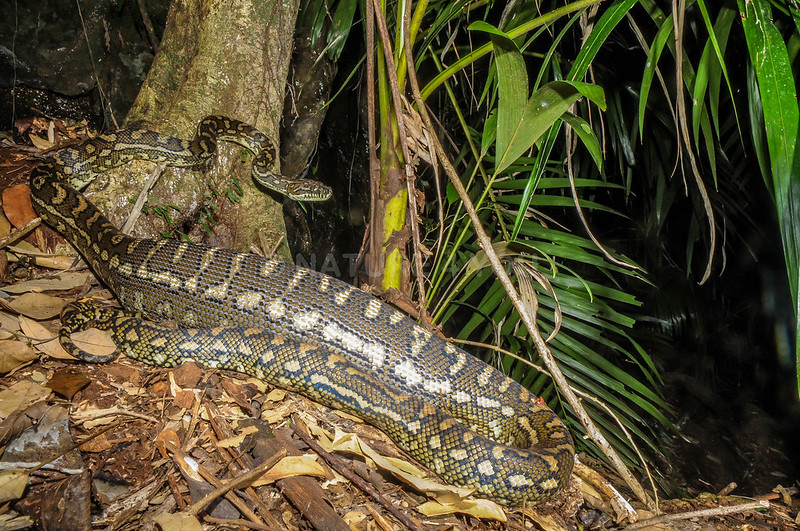
Pythons, like this rug python (Morelia spilota) tin can eat huge meals. Labial glands that secrete large quantities of mucous are an essential part of this process, as the mucous lubricates the meal, making it easier to swallow. Photo: Scott Eipper.
Ancestral ophidian strategies
Some species have both a "supralabial venom gland" and a rictal gland, others have one but not the other. In a few of the well-nigh "plesiomorphic" (similar to an inferred bequeathed land) snake lineages, the rictal gland is very large and the venom gland is reduced or absent-minded. In at least ane such serpent – the red-tailed piping snake (Cylindrophis ruffus) of Southeast Asia, the rictal gland expresses genes that encode neurotoxins in other ophidian lineages. Intriguingly, the tiny rictal glands of non-venomous constrictors also express genes encoding neurotoxins, and the secretions of these glands are toxic when injected into laboratory rodents. This doesn't necessarily mean that these snakes are "venomous", as the secretions of laboratory rodent salivary glands are likewise toxic when injected into laboratory rodents. However, it does provide nevertheless more interesting bear witness that can help us deconvolute the evolutionary history of snake venom systems (if information technology doesn't simply confuse us further). What seems clear is that the rictal glands were probably in one case part of a single maxillary dental gland in some ancestral serpent that is lost to the sands of time. This ancestral serpent may take been at least marginally venomous, deploying its toxin-rich oral secretions in combination with grappling/constriction/biting hard as function of a combined prey subjugation strategy, similar to that which is utilised by many extant snakes. Why some lineages have favoured the rictal gland over the venom gland and vice versa, and why others have retained both structures, is a question we still don't have an answer to.

The ruddy-tailed pipe snake (Cylindrophis ruffus) is believed by some researchers to exist similar in form to the ancestor of all snakes. This species has a large toxin-secreting rictal gland and subdues its prey by bitter it repeatedly and grappling with in (but not constricting). Is information technology "venomous"? We don't know. Photograph: Wikimedia Commons.
Venom glands
We could quite hands expend several thousand more words discussing variations on these themes, but permit's skip that and just become directly to the good stuff – the venom gland itself. Broadly speaking, the venom gland is the synapomorphy of the so-called "avant-garde snakes" (Caenophidia, Colubroidea, or Colubroides, depending on your preferred classification). By now, information technology will come as no surprise to hear that venom glands come in all shapes and sizes inside this spectacularly diverse clade, which contains 3 quarters of the world's species of snake. It is probably also predictable that this diversity in form has generated controversy surrounding which glands should be granted the title "venom gland". My personal preference is to go along things as simple as possible (since snake oral gland nomenclature is tediously complex at the all-time of times) and call the post-orbital (behind/beneath the eye) supralabial (associated with the upper lip) maxillary (of the upper jaw) protein-secreting dental gland of advanced snakes a "venom gland" wherever it occurs (so you can ignore all those other words). This may seem to contradict the lie well-nigh which species are venomous that has characterised previous episodes of this Tale, but here I am choosing to avoid arbitrarily complicating things past naming the gland after its most well-characterised role, rather than trying to draw circles around those well-nigh likely to exist specialised for that function and excluding those which may non be. Previously, the name "Duvernoy's gland" was used for this gland in non-forepart-fanged snakes and "venom gland" was reserved for front-fanged species. Personally, I feel this scheme only confuses things further because the name "Duvernoy'southward gland" is not usefully descriptive of form or part, the "venom glands" of forepart-fanged snakes evolved their similar features independently, and many not-front end-fanged snakes are quite clearly venomous. This debate about appropriate naming of homologous structures (structures arising from a common ancestor) is ongoing and is another case of the difficulty we take in suppressing our desires to carve nature into clearly divers categories. No affair which naming scheme is adopted, this dream cannot be fulfilled – at that place are simply too many shades of grey – which recommends usage of the near inclusive terms that can reasonably be justified. Nosotros must move on simply please see this newspaper for further details.

The large venom gland of this Papuan taipan (Oxyuranus scutellatus) is located "post-orbitally" (behind the eye) and is associated with the upper lip ("supralabial") and upper jaw ("maxillary"). Many terms have been used for this gland in its various forms, merely I adopt to avoid the jargon and simply call information technology a "venom gland" , wherever it occurs. Photo: Tom Charlton.
There are three lineages of front-fanged venomous snakes, each of which evolved the front-fanged status independently. These are the family unit Elapidae (cobras, taipans, and their relatives), the family unit Viperidae (vipers and pit vipers) and the clade containing the genera Atractaspis and Homoroselaps (stiletto snakes/mole vipers and harlequin snakes). As mentioned, the venom glands of these three lineages share certain features, which are associated with their being components of a "high-pressure level" venom commitment organization. The most notable of these is the zipper of compressor musculature which squeezes the gland during a bite (or a spit, in the case of spitting cobras), forcefully propelling the venom down the duct and through the hollow fang. The entire organisation is something similar a hypodermic needle. These shared features evolved convergently, however, and the glands are different in many respects, including which muscles adhere to them. For this reason, these glands are "homoplasic" (convergent in class and function), only the features which distinguish them from the venom glands of non-front end-fanged snakes are not homologous (descended from a mutual ancestor). In fact, evolving compressor musculature is such a peachy play tricks that information technology has occurred several times amid the non-front-fanged snakes too, albeit in a far less effective form – however again, nosotros seem to be catching development in the act by uncovering incipient forms of particular structures.
Extravagant extensions
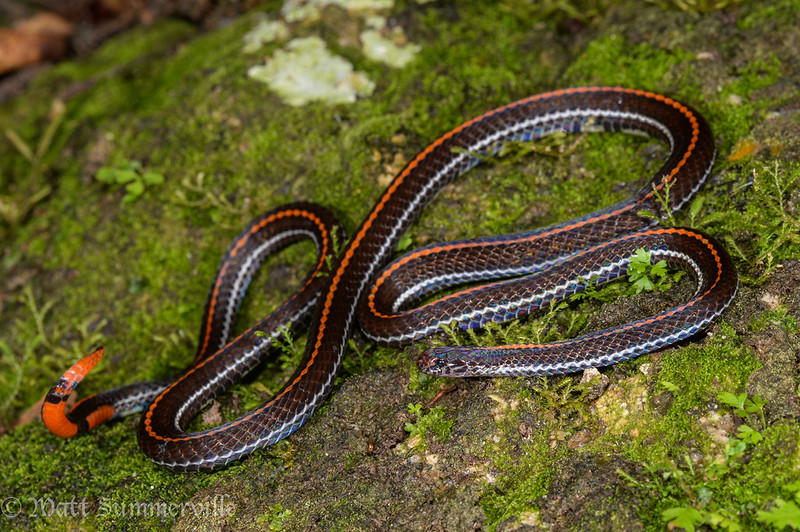 Incredibly, the venom glands of this banded coral snake (Calliophis intestinalis) extend well beyond the skull and down into the body crenel, for as much equally a quarter of the snake'due south trunk length! "Long-glanded" snakes exist in all three of the forepart-fanged clades, indicating that this condition has evolved multiple times independently (including two occasions inside the family Elapidae).....nobody really knows why. Photo: Matt Summerville.
Incredibly, the venom glands of this banded coral snake (Calliophis intestinalis) extend well beyond the skull and down into the body crenel, for as much equally a quarter of the snake'due south trunk length! "Long-glanded" snakes exist in all three of the forepart-fanged clades, indicating that this condition has evolved multiple times independently (including two occasions inside the family Elapidae).....nobody really knows why. Photo: Matt Summerville.
The venom glands of non-front-fanged snakes vary considerably in size and whether or non they possess a "lumen" (a infinite in the centre of the gland for the storage of secreted venom). The size of the gland, forth with the size of the associated teeth and whether or not they are grooved (which, by the mode, also varies a lot!) is non always correlated with the potency of the snake's venom or its apparent importance in their feeding ecology. Indeed, the venom glands of many non-front end-fanged snakes are considerably larger than those of many front-fanged elapid snakes, and those of the latter often lack a lumen despite their obvious importance in the feeding ecology of the snakes that possess them. Venom gland morphology is mostly conserved within each of the front-fanged lineages, but there are some weird and wonderful examples that buck this tendency. "Long-glanded" forms, in which the venom gland extends well beyond the head and into the body cavity, for as much as a quarter of the length of the snake (!) are found in each lineage. They tend to be possessed by burrowing species with relatively slender heads, just many closely related burrowing species lack them, and then the evolutionary "justification" for such extravagantly big glands remains unclear. It may but be the example that it just takes a small-scale genetic change to crusade the glandular tissue to break its usual bounds in this matter, and if there is fifty-fifty a slight selective advantage (and no significant penalty) to the possession of such glands then….why non? More than is more!
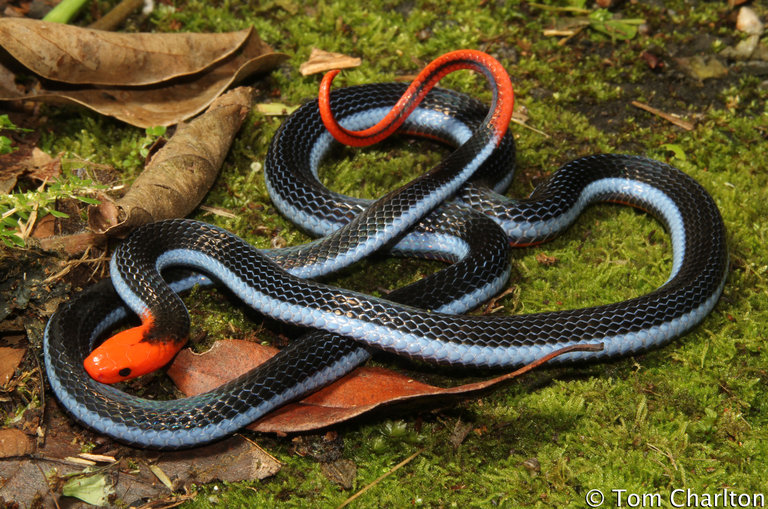 Similar its cousin the banded coral snake (pictured in a higher place), the spectacular blue coral snake (Calliophis bivirgatus) possesses extravagantly extended venom glands.
Similar its cousin the banded coral snake (pictured in a higher place), the spectacular blue coral snake (Calliophis bivirgatus) possesses extravagantly extended venom glands.
Use information technology or lose it

The mosaic sea ophidian (Aipysurus mosaicus) feeds on fish eggs. Every bit it apparently no longer has a need for venom, its venom glands and fangs are greatly reduced, to the point of existence "vestigial". Photo: Dave Gower.
Vestigial venom glands are also common among not-forepart-fanged snakes, and there are even a few examples amongst the elapids. Numerous non-front-fanged lineages have become specialised constrictors and seem to no longer accept a need for venom to subdue their prey. Accordingly, their venom glands shrink in size almost to the signal of disappearance (and occasionally do seem to disappear altogether), and the mucous-secreting region often extends to make full the vacant real estate forth the elevation jaw. Similar things happen when snakes start feeding on "defenceless" casualty, such as the eggs of fishes, frogs, birds, or other reptiles. Egg-eaters occur in many non-front-fanged lineages, and there are a number of elapid snakes that have also taken this road to easy living. Interestingly, the defensive function for which many snakes employ their venom seems insufficiently beneficial for these snakes to maintain a functional venom system, and it often withers away – "apply information technology or lose it" is a basic evolutionary principle. Forepart-fanged elapid snakes with apparently vestigial venom systems include sea snakes that feed exclusively on fish eggs. This behaviour, and the associated reduction of the venom arrangement, has evolved multiple times independently amid marine elapids. Perhaps even more surprising is the evidence that certain lineages may have transitioned back-and-forth, with essentially non-venomous snakes evolving from venomous species and so reverting to the functionally venomous condition. In evolution, whatsoever can happen, will happen!

The turtle-headed sea snake (Emydocephalus annulatus) is also an egg-eater with reduced venom glands, a condition it has evolved independently from the mosaic sea serpent (picture above). Photograph: Jenna Crowe-Riddell.
Exemplifying the plethora of possible forms of snake venom glands are the species of ophidian that think they are anguimorph lizards and have evolved toxin-secreting dental glands (functional "venom glands") on their lower jaw. These snakes, members of the genus Dipsas, are constitute in the tropical Americas, and possess the typical venom gland of the upper jaw as well as their unique mandibular arrangement. They insert their weaponised lower jaws into the shells of the snails they feed upon, envenoming the molluscs to brand them easier to extract (and possibly to reduce their production of slime).
There are more species of reptile than whatever other kind of back-boned animal – reptiles are the most speciose lineage of vertebrates on the planet. Some might quibble and say in that location are slightly more than species of birds than reptiles, only readers of this blog (and people interested in phylogenetics) know that birds are reptiles. In turn, Squamata (snakes and lizards) is by far the well-nigh speciose extant lineage of non-avian reptiles. In fact, over 96% of all reptile species alive (and described) on the planet today are members of this order. Snakes are (again, by some margin) the nearly speciose grouping of squamates, and specialised oral glands (including, but non express to, venom glands) are a big factor in the success of these limbless wonders. When this fact is considered alongside the variety of snake lifestyles, it becomes unsurprising that snake oral gland anatomy is a complicated field of study. We've only scratched the surface hither, but hopefully we've covered enough to reinforce the central point of this series on Toxicofera – the richness of transitional forms inside the clade makes any effort to draw lines in the sand unequivocally dividing the "venomous" from the "non-venomous", the "venom glands" from the "Duvernoy's glands" a hopeless endeavor. Again, categorising things is a useful aid to investigating them, just strictly defining these categories is a far less interesting and important task than taking advantage of the opportunity the grey areas present for us to proceeds insight into the many-branching path traversed past organismal lineages over evolutionary time.
Melody in next week for more evolutionary thinking!
- Timothy
Source: https://biomedicalsciences.unimelb.edu.au/departments/department-of-biochemistry-and-pharmacology/engage/avru/blog/the-tale-of-toxicofera,-part-5
Posted by: hopkinswiturpred.blogspot.com


0 Response to "How To Draw Venom With No Legs Just Is Slime"
Post a Comment